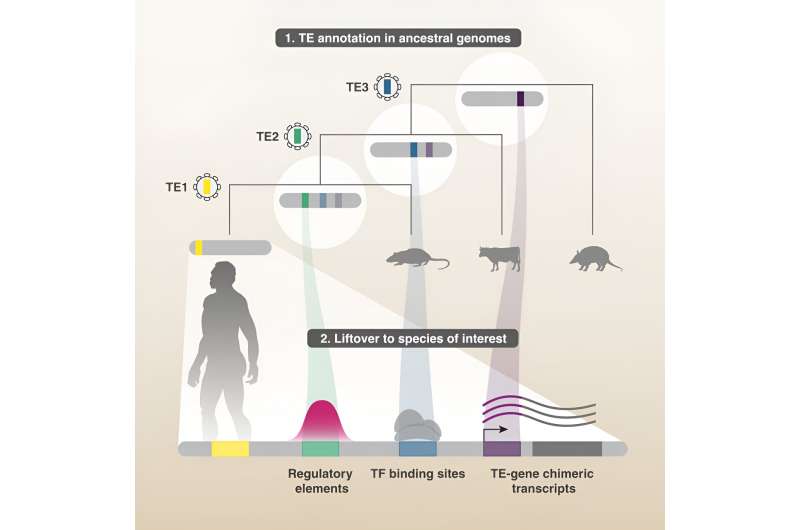This article has been reviewed according to Science X's editorial process and policies. Editors have highlighted the following attributes while ensuring the content's credibility:
fact-checked
peer-reviewed publication
trusted source
proofread
'Genomic time machine' reveals secrets of our DNA

The human genome, an intricate tapestry of genetic information for life, has proven to be a treasure trove of strange features. Among them are segments of DNA that can "jump around" and move within the genome, known as "transposable elements" (TEs).
As they change their position within the genome, TEs can potentially cause mutations and alter the cell's genetic profile, but also are master orchestrators of our genome's organization and expression. For example, TEs contribute to regulatory elements, transcription factor binding sites, and the creation of chimeric transcripts—genetic sequences created when segments from two different genes or parts of the genome join together to form a new, hybrid RNA molecule.
Matching their functional importance, TEs have been recognized to account for half of the human DNA. However, as they move and age, TEs pick up changes that mask their original form. Over time, TEs "degenerate" and become less recognizable, making it difficult for scientists to identify and track them in our genetic blueprint.
In a new study, researchers in the group of Didier Trono at EPFL have found a way to improve the detection of TEs in the human genome by using reconstructed ancestral genomes from various species, which allowed them to identify previously undetectable degenerate TEs in the human genome. The study is published in Cell Genomics.
The scientists used a database of reconstructed ancestral genomes from different kinds of species, like a genomic "time machine." By comparing the human genome with the reconstructed ancestral genomes, they could identify TEs in the latter that, over millions of years, have become degenerate (worn out) in humans.
This comparison allowed them to detect ("annotate") TEs that might have been missed in previous studies that used data only from the human genome.
Using this approach, the scientists uncovered a larger number of TEs than previously known, adding significantly to the share of our DNA that is contributed by TEs. Furthermore, they could demonstrate that these newly unearthed TE sequences played all the same regulatory roles as their more recent, already identified relatives.
The potential applications are vast: "Better understanding TEs and their regulators could lead to insights into human diseases, many of which are believed to be influenced by genetic factors," says Didier Trono. "First and foremost, cancer, but also auto-immune and metabolic disorders, and more generally our body's response to environmental stresses and aging."
More information: Wayo Matsushima et al, Ancestral genome reconstruction enhances transposable element annotation by identifying degenerate integrants, Cell Genomics (2024). DOI: 10.1016/j.xgen.2024.100497. www.cell.com/cell-genomics/ful … 2666-979X(24)00024-7
Journal information: Cell Genomics
Provided by Ecole Polytechnique Federale de Lausanne




















